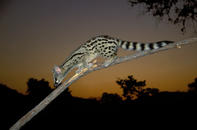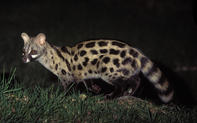Two Tails
There are two species of genet in the Lowveld, the Large Spotted Genet (Genetta tigrina) and the Small Spotted Genet (Genetta genetta).

The easiest way to tell these two very similar looking animals apart is by looking at the tip of the tail, which is black in the Large Spotted Genet and white in the Small Spotted Genet. This is quite a reliable method since these animals are shy and often seen fleetingly as they run for cover.
Like the civet, genets belong to the carnivore family known as Viverridae, which use anal glands extensively in the marking of their territories. Genet’s anal gland secretion has a musky smell, which retains its scent for up to 9 weeks.
They also make use of middens, which are usually near their dens and easy to recognize because their droppings contain copious insect fragments. During the day genet’s shelter in holes or in thick cover.
Cat Like

Although they are agile climbers, genets generally forage on the ground stalking rushing and pouncing on prey in the manner of a cat. They will take to trees if searching for birds, eggs or fruit or if they are frightened.
They may also engage in pilo-erection raising the crest of long black hair along their backs to appear larger and more intimidating. As with civets, the white patches below their eyes and up the forehead are used to enhance their facial expressions when engaged in social interactions.
These encounters are rare due to their predominantly solitary lifestyles but essential none-the-less when dispelling intruders or finding mates. Genets, remarkably, also have seven different vocal signals with which to communicate.
By Megan Emmett
 Size: Small spotted: 94 cm. Large spotted: 98 cm. Weight: Small spotted: 1,9 kg (female 1,8 kg). Large spotted: 2kg (female 1,8 kg). Lifespa...
Size: Small spotted: 94 cm. Large spotted: 98 cm. Weight: Small spotted: 1,9 kg (female 1,8 kg). Large spotted: 2kg (female 1,8 kg). Lifespa... The large-spotted genet of South Africa is short legged with retractable claws for climbing. They have a brown-tan coat covered in rows of r...
The large-spotted genet of South Africa is short legged with retractable claws for climbing. They have a brown-tan coat covered in rows of r... In South Africa, the small-spotted genet produces two litters per year. Litters comprise of between two to three young with a gestation peri...
In South Africa, the small-spotted genet produces two litters per year. Litters comprise of between two to three young with a gestation peri...